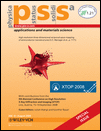Cover Picture (Phys. Status Solidi A 8/2009)
Graphical Abstract
The cover picture of this issue depicts the 3D isosurface of a [111] Bragg point from a GaAs nanowire with four crystal truncation rods originating from the wires' microfacets. Two crystal truncation rods more are hidden behind the increased noise caused by the Bragg point itself. To obtain such highquality 3D reciprocal space maps, Mariager et al. (pp. 1771–1774) employ a 2D Pilatus 100k detector in combination with a surface diffractometer and a set of mathematical routines for the conversion to reciprocal space coordinates. The described method is a promising tool for the structural characterization of nanostructures and, due to the deep penetration of hard X-rays, it could be especially useful for embedded structures where traditional techniques such as SEM and TEM have severe limitations.
The paper is part of the XTOP 2008 Proceedings published in this issue on pp. 1689–1884.





